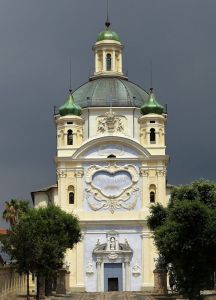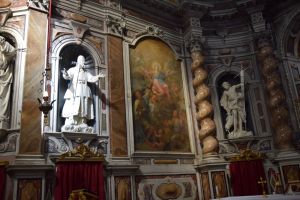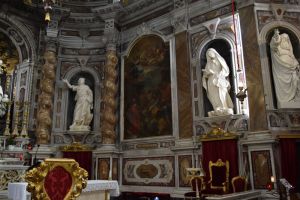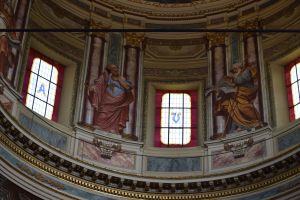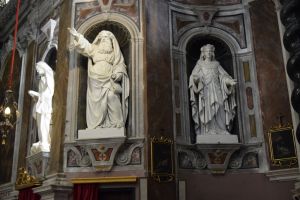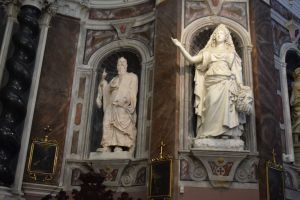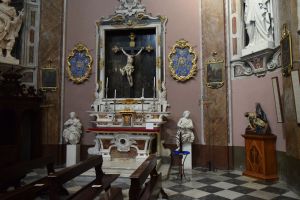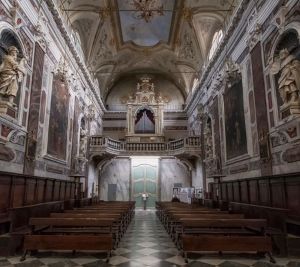The ancient Sanctuary that dominates the City
The History
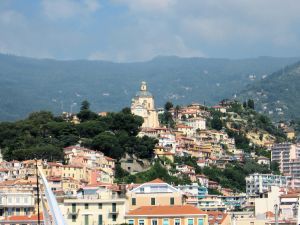 The sanctuary, the sacred place most dear to the people of Sanremo together with the co-cathedral of San Siro, dominates the whole city from the most
The sanctuary, the sacred place most dear to the people of Sanremo together with the co-cathedral of San Siro, dominates the whole city from the most 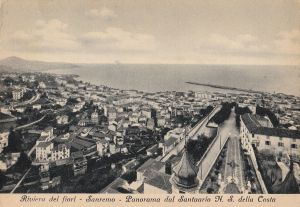 panoramic and central point of Sanremo. The large building, visible even from a considerable distance, has always been, especially for sailors, a sure point of reference, especially from a spiritual point of view.
panoramic and central point of Sanremo. The large building, visible even from a considerable distance, has always been, especially for sailors, a sure point of reference, especially from a spiritual point of view.
The origins of the present sanctuary probably date back to the 14th century, when the castle (castrum) where it would have been built and belonged to the Doria family, in 1361 was sold, together with the city (which was then called Castrum Sancti Romuli) to the Republic of Genoa, putting an end to its feudal state by the Doria themselves.
Some local faithful particularly devoted to the Virgin Mary would have promoted the erection of an Oratory dedicated to the Virgin Mary, where there was an altarpiece depicting a Madonna with Child and two saints on its sides: almost certainly St. Nicholas and St. Erasmus, patron saints of the people of the sea. The devotion for that figure has always been remarkable.
It was on that occasion that the annual celebration of the "festivity of the chains" was born, where the people of Sanremo went in procession to the sanctuary dragging chains, to remember the breaking of the chains that kept the city under the yoke of the Doria feudalism.
The increasing number of the faithful, who came to the small country Oratory especially to venerate the sacred image of the Madonna and Child, made it necessary to celebrate a  Mass inside the sacred building.
Mass inside the sacred building.
The first document mentioning the religious building dates back to 1474 where the local Fabiani family described the presence of a chapel in that place.  In the same year the Fabiani brothers founded a chaplaincy there, taking on the financial burden of establishing the fixed residence of a chaplain in the oratory with the obligation to celebrate Holy Mass there daily.
In the same year the Fabiani brothers founded a chaplaincy there, taking on the financial burden of establishing the fixed residence of a chaplain in the oratory with the obligation to celebrate Holy Mass there daily.
The historical event is remembered in a plaque, affixed in the Memorial Hall of the sanctuary on 1st August 1950, in which the data concerning the foundation of the chaplaincy with the names of the promoters of the initiative and the details of the relevant notarial deeds are mentioned, whose authentic copy was kindly donated to the Archive of the sanctuary that same day by the lawyer Antonio Fabiani.
In 1600, in order to fulfill a "vow" to the Virgin who had miraculously saved him from the assault of pirates during a shipwreck, a sailor from Sanremo poured a golden shield and opened a subscription among the inhabitants of the Civitas Sancti Romuli who wanted to build a Sanctuary, great, rich, harmonious, visible from all over the City and also from sailors, on the site of the old oratory, which had become dilapidated and in fact insufficient to contain the increased number of the faithful, both for the Feast of the Chains, for the Feast of the Assumption of August 15 and other religious celebrations.
On that occasion, the icon of Our Lady of the Coast, (which some people refer to as the direct work of St. Luke, but more detailed studies on the work attribute it to the hand of the painter Barnaba da Modena (14th century), while others consider it the work of the painter Nicolò da Voltria Nicolò da Voltri), was modified and reduced to frame it in the "glory" above the valuable marble altar.
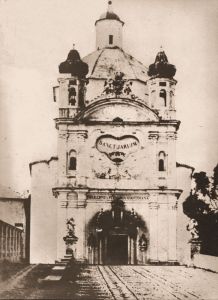 Despite the enormous expenses for the erection of the sanctuary, in 1630 the building was finally finished, with the exception of the large dome, which would have been finished in Michelangelo's style between 1770 and 1775 on a project by the architect Domenico Belmonte from Oneglia, thanks also to the financing of the noble Borea d'Olmo family from Sanremo.
Despite the enormous expenses for the erection of the sanctuary, in 1630 the building was finally finished, with the exception of the large dome, which would have been finished in Michelangelo's style between 1770 and 1775 on a project by the architect Domenico Belmonte from Oneglia, thanks also to the financing of the noble Borea d'Olmo family from Sanremo.
The sanctuary was solemnly consecrated on 1st November 1832 by the Bishop of Ventimiglia Giovanni Battista D'Albertis, just over a year after the passage of Sanremo under the ecclesiastical jurisdiction of the Diocese intemelia.
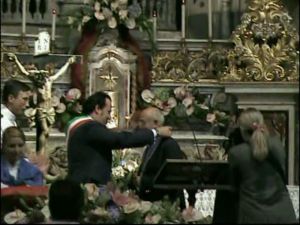
 Among the many celebrations and anniversaries, such as the "Feast of the Chains", already mentioned, which ceased in 1828, or the "quindenni", it should be remembered that since 1397 there was the Sailors' Consulate, an association to which all sailors over twenty years of age had to be registered. Guarantors of the rules of conduct and of the Statute were the Consuls of the Sea who were elected in Sanremo and were in charge of judging and settling all disputes concerning seafaring.
Among the many celebrations and anniversaries, such as the "Feast of the Chains", already mentioned, which ceased in 1828, or the "quindenni", it should be remembered that since 1397 there was the Sailors' Consulate, an association to which all sailors over twenty years of age had to be registered. Guarantors of the rules of conduct and of the Statute were the Consuls of the Sea who were elected in Sanremo and were in charge of judging and settling all disputes concerning seafaring.
Today the office has a purely honorary character.
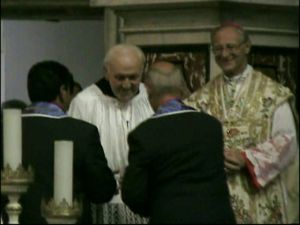 Their appointment every two years (or almost) is entrusted to the Municipality with the bishop's approval. Lately some disagreements have arisen between the two authorities because the ceremony always took place inside the Madonna della Costa during the solemn mass of the feast of the Assumption on 15th August, but the new bishop considered it a secular ceremony, to be celebrated outside the places of worship. It seems, however, that in the end a compromise was found.
Their appointment every two years (or almost) is entrusted to the Municipality with the bishop's approval. Lately some disagreements have arisen between the two authorities because the ceremony always took place inside the Madonna della Costa during the solemn mass of the feast of the Assumption on 15th August, but the new bishop considered it a secular ceremony, to be celebrated outside the places of worship. It seems, however, that in the end a compromise was found.
(the relative images come from a private film and the Web).
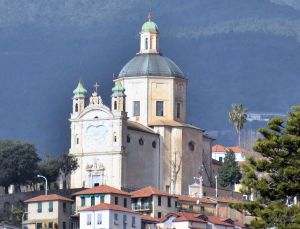 The sacred building, situated at the top of the hill of the "Scarpéta", (dialectal voice referring to the Pigna) at 100 metres above sea level, is reached by a
The sacred building, situated at the top of the hill of the "Scarpéta", (dialectal voice referring to the Pigna) at 100 metres above sea level, is reached by a 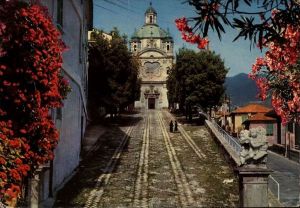 pedestrian ramp lined with cypresses and olive trees, still entirely cobbled in black and white coloured rissoles with geometric patterns and preceded by a staircase, which is detached from the carriageway to San Romolo, while in the area below the sanctuary is located the area already occupied by the city's castle, demolished by the Genoese after the well-known revolutionary events of 1753.
pedestrian ramp lined with cypresses and olive trees, still entirely cobbled in black and white coloured rissoles with geometric patterns and preceded by a staircase, which is detached from the carriageway to San Romolo, while in the area below the sanctuary is located the area already occupied by the city's castle, demolished by the Genoese after the well-known revolutionary events of 1753.
In the background of the staircase there are some pylons on which marble angels bearing the symbols of the Immaculate Virgin Mary stand out. The angels were certainly made by a workshop in the Lombard-Genovese area in the early 17th century, and perhaps by a typical sculptor of the period like Leonardo Mirano (1577-1637).
 The large churchyard has a characteristic pebble mosaic floor enriched with decorative motifs. This work, of purely Ligurian style and in which the coat of arms of Genoa stands out in particular, was executed in 1651, as can be seen from the date on the floor itself.
The large churchyard has a characteristic pebble mosaic floor enriched with decorative motifs. This work, of purely Ligurian style and in which the coat of arms of Genoa stands out in particular, was executed in 1651, as can be seen from the date on the floor itself.
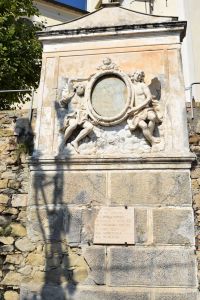 On a wall below the sanctuary there is an aedicule with an image of the Madonna della Costa restored to its original position in 1968 by Famija Sanremasca.
On a wall below the sanctuary there is an aedicule with an image of the Madonna della Costa restored to its original position in 1968 by Famija Sanremasca.
The sanctuary, which measures 37 metres in length internally, 17 metres in the cruises and 9 metres in width, with the dome that reaches 50 metres above the ground, is in light and graceful baroque forms, which harmonise well with the surrounding landscape. The façade is rectilinear, articulated on two orders of pilasters, it is concluded by a curved pediment and has two small bell towers on the sides, surmounted by small domes.
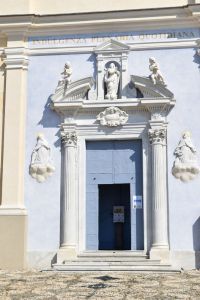
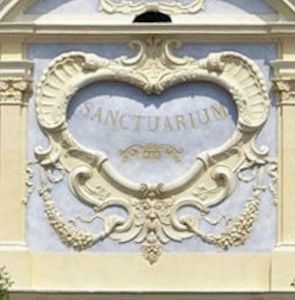 In the centre is the large marble portal, with a marked classicist design, framed by two columns with white marble capitals, surmounted by an aedicule with the statue of the Assumption, venerated by two angels, while the marble reliefs of St. Siro and St. Romolo are engraved on either side of the portal. In the upper order a large occluded window, surrounded by friezes and stucco decorations, contains the inscription Sanctuarium.
In the centre is the large marble portal, with a marked classicist design, framed by two columns with white marble capitals, surmounted by an aedicule with the statue of the Assumption, venerated by two angels, while the marble reliefs of St. Siro and St. Romolo are engraved on either side of the portal. In the upper order a large occluded window, surrounded by friezes and stucco decorations, contains the inscription Sanctuarium.
Between 1980 and 1986 some restorations were carried out that brought the whole building back to its original splendour. In the course of these interventions, the copper covering of the dome and the two side domes were rebuilt, the facade was painted, numerous works of art in the church were restored, several dangerous stuccoes were consolidated and the electrical systems located both inside and outside the building were arranged in a convenient and functional way.
The art of Church
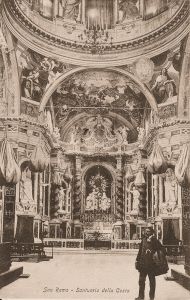
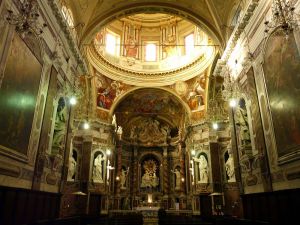 The vast and majestic interior with a single rectangular hall has a series of full-height transverse chapels with curved walls of eighteenth-century matrix. The space is defined in particular by the large dome on a high drum, circular inside and polygonal outside, with large windows.
The vast and majestic interior with a single rectangular hall has a series of full-height transverse chapels with curved walls of eighteenth-century matrix. The space is defined in particular by the large dome on a high drum, circular inside and polygonal outside, with large windows.
In the presbyterial area stands out the artistic high altar, made starting from 1699 by the Ticinese Gio Andrea Manni (1658-1723) in polychrome marble and porphyry, which is located in a room surrounded by four spiral columns in tawny alabaster, 4.37 metres high and donated to the sanctuary in 1728 by an abbot of the Borea d'Olmo family.
The predella of the above mentioned altar is also a refined example of polychrome marble inlay with a geometric design.
I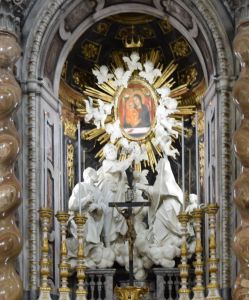 n the centre is a wooden statuary group by the Genoese sculptor Anton Maria Maragliano (1664-1741), representing St. Joseph, St. Joachim and St. Anne, portrayed in veneration of the miraculous oval painting of the Madonna and Child, surrounded by statues of little angels.
n the centre is a wooden statuary group by the Genoese sculptor Anton Maria Maragliano (1664-1741), representing St. Joseph, St. Joachim and St. Anne, portrayed in veneration of the miraculous oval painting of the Madonna and Child, surrounded by statues of little angels.
![]() This famous oil painting, the oldest preserved in Sanremo, object of deep veneration by the people of Sanremo and already attributed by popular tradition to St. Luke, is actually a fragment of an altarpiece attributed to Fra' Nicolò da Voltri (news 1385-1417) and dated 1401.
This famous oil painting, the oldest preserved in Sanremo, object of deep veneration by the people of Sanremo and already attributed by popular tradition to St. Luke, is actually a fragment of an altarpiece attributed to Fra' Nicolò da Voltri (news 1385-1417) and dated 1401.
The work represents a magnificent example of late 14th century Italian painting, so much so that it stands out from all other artistic artefacts in Sanremo for its particularly delicate, refined and refined workmanship.
It underwent careful restoration in 1951, and with its original dimensions of 55 x 80 cm, it was adapted to the slightly larger oval support (67 x 88 cm).
Originally the central figures were flanked by Saints Syrian and Romulus, patron saints of the city, of whom parts of the clothes can still be glimpsed, while in the upper corners two angel heads support the drapery of the Virgin, embellished with applied golden threads. On the halo surrounding the head of the Madonna is the inscription Ave Maria Virgo et Mater Dei.
The three statues above the altar, made in 1735, were followed on the left by Maragliano's work, those of St. John the Baptist and St. John the Evangelist, both carved in 1735 and also in wood, and on the right by St. Zaccaria and St. Elizabeth, completed in 1737.
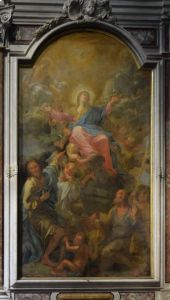
 On both sides between the statues, there are portraits of which on the left is the canvas of the Madonna and Child, surrounded by the Dominican Saint Vincenzo Ferreri, some little angels and a noble personage gathered in prayer. The work, made by Domenico Fiasella, known as Sarzana (1589-1669) and donated to the Sanctuary in 1846 by Marquis Giuseppe and Francesco Carrega, comes from the Genoese church of San Domenico, which was demolished in the 19th century to build the Carlo Felice Theatre in its place.
On both sides between the statues, there are portraits of which on the left is the canvas of the Madonna and Child, surrounded by the Dominican Saint Vincenzo Ferreri, some little angels and a noble personage gathered in prayer. The work, made by Domenico Fiasella, known as Sarzana (1589-1669) and donated to the Sanctuary in 1846 by Marquis Giuseppe and Francesco Carrega, comes from the Genoese church of San Domenico, which was demolished in the 19th century to build the Carlo Felice Theatre in its place.
On the right, a valuable oil on canvas depicting the Beheading of St. John the Baptist, perhaps made by Giulio Cesare Procaccini (1574-1625), a member of the homonymous dynasty of painters originating from Bologna and active between the 16th and 17th centuries.
 To delimit the area of the presbytery, on 3 August 1896 an artistic balustrade in marble and pale tawny oriental alabaster was placed there, made in Pietrasanta by Domenico Carli, while the relative wrought iron gate was made in Milan in 1898 to a design by Count Oldofredi and placed here in March 1899.
To delimit the area of the presbytery, on 3 August 1896 an artistic balustrade in marble and pale tawny oriental alabaster was placed there, made in Pietrasanta by Domenico Carli, while the relative wrought iron gate was made in Milan in 1898 to a design by Count Oldofredi and placed here in March 1899.
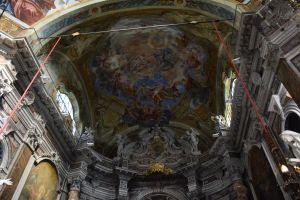 I
I n the large central vault, restored in 1985, you can admire some paintings executed in two distinct phases during the nineteenth century, namely the architectural and floral decorations made by the Lombard Siro Orsi in 1843 and the central medallion with the large "M", a work of 1890 by the painters Malpelli and Marazzini.
n the large central vault, restored in 1985, you can admire some paintings executed in two distinct phases during the nineteenth century, namely the architectural and floral decorations made by the Lombard Siro Orsi in 1843 and the central medallion with the large "M", a work of 1890 by the painters Malpelli and Marazzini.
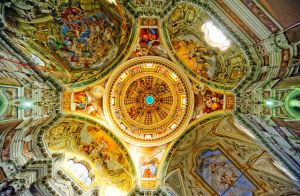
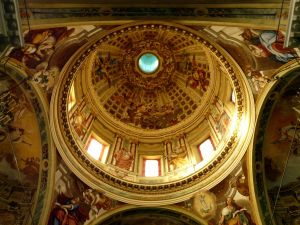 The cruise topped by Michelangelo's grandiose dome stands out especially for the paintings that adorn it, as well as for the stucco and pure gold rosettes.
The cruise topped by Michelangelo's grandiose dome stands out especially for the paintings that adorn it, as well as for the stucco and pure gold rosettes.
In the sails that connect the lower part with the drum cornice stand out the four evangelists: St. Mark, St. Luke, depicted in the act of painting a painting  of the Madonna according to an ancient legend, St. John and St. Matthew.
of the Madonna according to an ancient legend, St. John and St. Matthew.
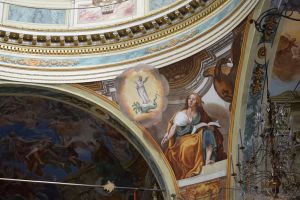 These paintings, very refined but by an unknown author, were made in the first half of the nineteenth century and finally restored in 1984.
These paintings, very refined but by an unknown author, were made in the first half of the nineteenth century and finally restored in 1984.
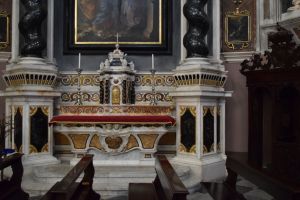 In the transept to the right of the transept there is the altar called "dei Grimaldi", coming from the monastery of the Visitation, which was in Piazza Colombo and was demolished
In the transept to the right of the transept there is the altar called "dei Grimaldi", coming from the monastery of the Visitation, which was in Piazza Colombo and was demolished 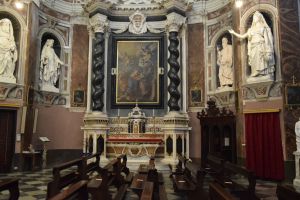 after the end of the last world war.
after the end of the last world war.
The altar was donated in 1708 by the Prince of Monaco Antonio I Grimaldi to the Monastery of the Visitation of Sanremo, where a sister of the Prince himself acted as abbess.
Especially noteworthy are the two spiral columns of black Valencian marble minutely mottled, which adorn the altar, which bears the red and white lozenge coat of arms of the Grimaldis of Monaco at the top, in the centre.
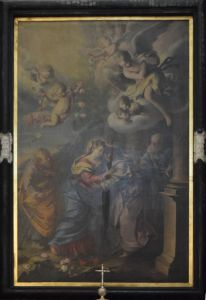 The altarpiece of this altarpiece represents the Visit of Mary to St. Elizabeth, a delicate work by Bartolomeo Guidobono from Savona (1654-1709) and aids, while above the altar there is a fresco, restored in 1984, depicting a saint in glory.
The altarpiece of this altarpiece represents the Visit of Mary to St. Elizabeth, a delicate work by Bartolomeo Guidobono from Savona (1654-1709) and aids, while above the altar there is a fresco, restored in 1984, depicting a saint in glory.
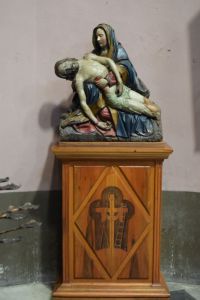 In place of Guidobono's altarpiece, the famous painting of St. Napoleon by Maurizio Carrega was placed in 1808, then removed in 1815 (and currently kept in a room of the Civic Museum) to be replaced by the painting of St. Philip Neri dying, which remained here until 1952, the year of the transfer to the sanctuary of today's altar.
In place of Guidobono's altarpiece, the famous painting of St. Napoleon by Maurizio Carrega was placed in 1808, then removed in 1815 (and currently kept in a room of the Civic Museum) to be replaced by the painting of St. Philip Neri dying, which remained here until 1952, the year of the transfer to the sanctuary of today's altar.
In the same right transept there is also a wooden work of the sixteenth century by an unknown author, representing the Mater dolorosa con il Cristo morto.
On either side are four imposing plaster statues, representing Judith and Moses, both works by Filippo Ghersi, Queen Esther, by an unknown author, and the prophet Ezekiel, sculpted by Domenico Carli from Sanremo.
In the left transept there is a polychrome marble altar dating back to 1723 and surmounted by the valuable Crucifix by Gaetano Solaro, already active in the church of Santa Maria degli Angeli.
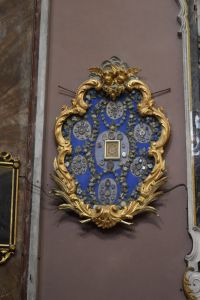
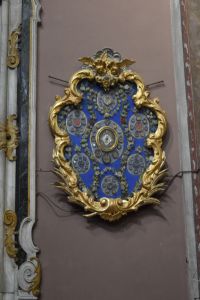 On the sides there are two gilded wooden reliquaries by the Venetian sculptor Marco Bastianelli, who made them in 1874.
On the sides there are two gilded wooden reliquaries by the Venetian sculptor Marco Bastianelli, who made them in 1874.
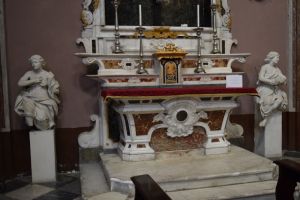 The altar of the Crucifix of Solaro is surmounted by a fresco, painted by an unknown artist and also restored in 1984, in which the Risen Christ is depicted.
The altar of the Crucifix of Solaro is surmounted by a fresco, painted by an unknown artist and also restored in 1984, in which the Risen Christ is depicted.
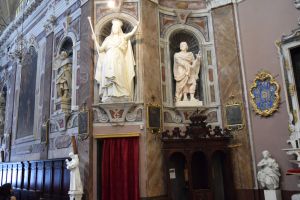
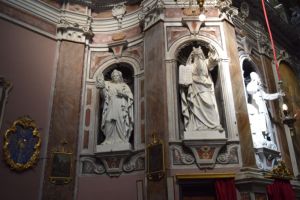 On this side, as on the right, there are four large plaster statues representing Moses, Judith, Esther and St. Paul, the first two of which were made by Filippo Ghersi, the third by Domenico Carli and the fourth by an unknown artist.
On this side, as on the right, there are four large plaster statues representing Moses, Judith, Esther and St. Paul, the first two of which were made by Filippo Ghersi, the third by Domenico Carli and the fourth by an unknown artist.
The characters of Moses, Judith and Esther are therefore represented in the relative statues both on the right and on the left of the cruise, even if it is clear that these works were obviously made by different authors, besides being clearly marked by different artistic value.
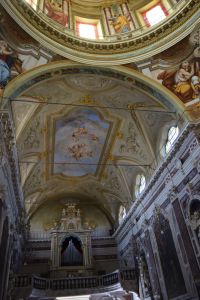 On the ceiling of the vault there is a fresco representing the Assumption of Mary, painted in 1727 by Giacomo Antonio Boni (1688-1766), a Bolognese artist and pupil of Marcantonio Franceschini, the already remembered author of the altarpiece preserved in the church of Santa Maria degli Angeli. Boni was called to Sanremo perhaps at the suggestion of the abbot Pietro Francesco Borea. The quadraturist Pietro Revello and Gio Siro Ferrata collaborated with Boni in the realisation of the great fresco of the vault, who in 1727 executed the precious golden stuccoes of the presbyterial area.
On the ceiling of the vault there is a fresco representing the Assumption of Mary, painted in 1727 by Giacomo Antonio Boni (1688-1766), a Bolognese artist and pupil of Marcantonio Franceschini, the already remembered author of the altarpiece preserved in the church of Santa Maria degli Angeli. Boni was called to Sanremo perhaps at the suggestion of the abbot Pietro Francesco Borea. The quadraturist Pietro Revello and Gio Siro Ferrata collaborated with Boni in the realisation of the great fresco of the vault, who in 1727 executed the precious golden stuccoes of the presbyterial area.
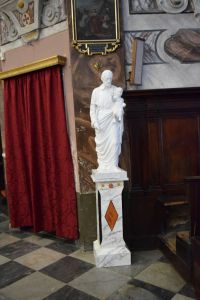
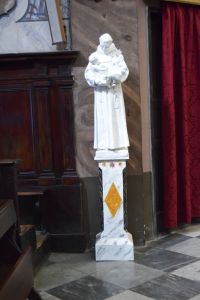 Statue of St. Joseph on the rightIn front of the chapel on the right as well as the one on the left there are two representatives respectively of St. Joseph with Child and St. Francis, also with Child.
Statue of St. Joseph on the rightIn front of the chapel on the right as well as the one on the left there are two representatives respectively of St. Joseph with Child and St. Francis, also with Child.
These open the view on the long side of the nave where, leaning against the right and left walls and leaning against the ceiling, are the characteristic 18th century wooden seats or stalls of the brethren, who used to meet periodically inside the sanctuary to pray or to participate in the sacred functions.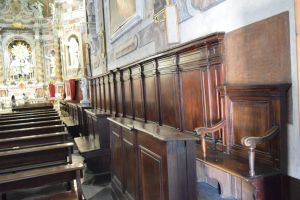
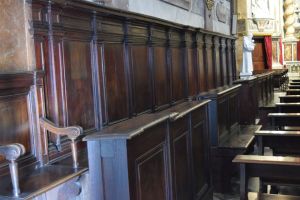
On both walls alternate niches with statues of saints and paintings on canvas.
On the right side there is a wooden statue representing the prophet Isaiah, also by Maragliano or his school, as well as the wooden statue of the prophet Jeremiah, placed on the left 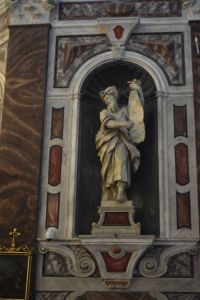 side of the church near the main door. Also on the right side is the painting on canvas depicting The Apostles visiting the tomb of the Virgin, made by Boni himself in 1731.
side of the church near the main door. Also on the right side is the painting on canvas depicting The Apostles visiting the tomb of the Virgin, made by Boni himself in 1731.
On the left side, towards the high altar there is the wooden statue of the king and prophet David, also attributed to Maragliano or his school. Still on the left side 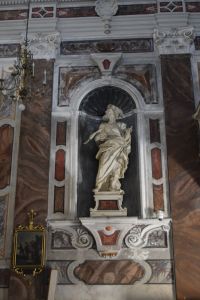 there is another painting with the Assumption between Saints James and Philip, painted in 1730 by Giovanni Odazzi (1663-1731), one of the pupils of the painter Gio Batta Gaulli called the Baciccio, who was one of the main protagonists of the Baroque season in Rome.
there is another painting with the Assumption between Saints James and Philip, painted in 1730 by Giovanni Odazzi (1663-1731), one of the pupils of the painter Gio Batta Gaulli called the Baciccio, who was one of the main protagonists of the Baroque season in Rome.
Along the walls of the church there are paintings representing the Via Crucis. On both sides immediately after the entrance there are two sculpted stoups.
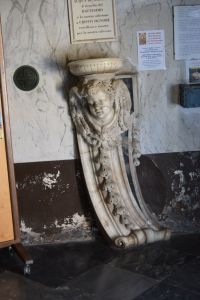
Above the entrance door is the large pipe organ with its tribune. Its realization was entrusted on November 9, 1838 to professor Antonio Buzzoni, who delivered the new organ on the occasion of the feast of the Assumption in 1839.
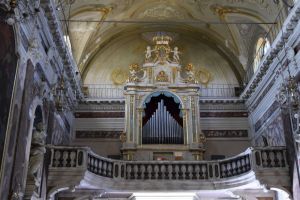 Remarkable is the wooden case of the middle of the eighteenth century embellished by an elegant play of colours and enriched by an artistic ornament, also made of wood, in which some angelic figures are depicted around a heraldic shield, in the centre of which stands out a large letter "M", initial that naturally stands for "Maria".
Remarkable is the wooden case of the middle of the eighteenth century embellished by an elegant play of colours and enriched by an artistic ornament, also made of wood, in which some angelic figures are depicted around a heraldic shield, in the centre of which stands out a large letter "M", initial that naturally stands for "Maria".
After the approval of an initial restoration on June 3, 1860, the instrument was restored towards the end of the 19th century by the organ builder Giovanni Mentasti. In the first years of the twentieth century other interventions were carried out, while in 1936 a certain Sacchetto di Imperia put in a further restoration.
In 1986 the Administration of the Sanctuary entrusted the organ builder Silvio Chiara of Chieti with the task of disassembling the organ in order to ascertain the damage caused by lightning or other bad weather, and restore the instrument to its original harmonic composition; in addition to the recovery of the organ, several interventions were also carried out to consolidate the tribune.
The new organ was then presented to the numerous community of the faithful of the Madonna della Costa during the celebrations for the feast of the Assumption on 15th August 1986, which were particularly impressive because of the tenth fifteen years, the traditional votive procession held every fifteen years since 1835 in honour of the Madonna, who had preserved the city from a very serious cholera epidemic and whose sacred effigy is carried in procession along the streets of Sanremo.
(sources: free reworking based on texts by Andrea Gandolfo, Ernesto Porri and others; personal and web images)





